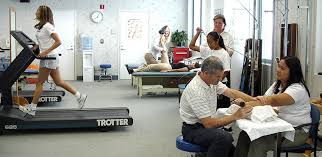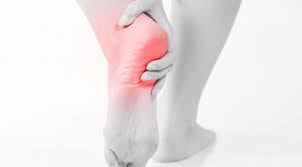Written by Sean on November 2, 2017 |

Going to a physical therapy clinic for the first time can be very similar to your first day of school. You might have some nerves about meeting the therapists and the exercise specialists, much like the nerves that you get when you are meeting your teacher or professor for the first time. And as everyone who has survived their first day of school or therapy knows, your teachers or therapists are there to educate you and help you reach your goals.
Continue Reading »
Written by Sean on October 29, 2017 |

Have you ever wondered who this “kid” helping you with exercises is? Well this “kid” is not a kid, rather a young adult who has either completed or is in the process of completing their education to receive their bachelor’s degree. The title that this “kid” holds is Exercise Specialist, meaning that he or she has the knowledge and training to show patients how to perform the exercises that they are given by the therapist safely and correctly. As a patient, if you are experiencing pain or discomfort while performing an exercise just tell an Exercise Specialist, who is always around, and they will help you modify the exercise to where you won’t feel the pain or discomfort while still targeting the muscle groups that the exercise intends. If we, exercise specialists, see that a patient is struggling with an exercise because of discomfort, even with modification of the exercise, we will make a note of that for the therapist and move the patient on to the next exercise. We do this because patients come into the clinic to get better, not to regress.
Continue Reading »
Written by Laura on September 20, 2017 |
 Most people know the importance of ergonomics and how it can help decrease injury at work. Ergonomics (per OSHA) is the study of work and is based on the principle that the job should be adapted to fit the person, rather than forcing the person to fit the job. Ergonomics includes restructuring or changing workplace conditions to make the job easier and reducing/stressors that cause cumulative trauma disorders and repetitive motion injuries. There are a few things like taking micro breaks and setting up “work zones” that can decrease stress and repetition that doesn’t take anyone coming to your work station and making adjustments.
Most people know the importance of ergonomics and how it can help decrease injury at work. Ergonomics (per OSHA) is the study of work and is based on the principle that the job should be adapted to fit the person, rather than forcing the person to fit the job. Ergonomics includes restructuring or changing workplace conditions to make the job easier and reducing/stressors that cause cumulative trauma disorders and repetitive motion injuries. There are a few things like taking micro breaks and setting up “work zones” that can decrease stress and repetition that doesn’t take anyone coming to your work station and making adjustments.
Continue Reading »
Written by Laura on September 10, 2017 |

In order to understand Achilles tendonitis, we must understand the Achilles tendon. Per WebMD, “the Achilles tendon is a tough band of fibrous tissue that connects the calf muscles to the heel bone (calcaneus)”. The gastrocnemius and soleus muscles (calf muscles) blend together, becomes the Achilles tendon, and inserts into the heel.
Continue Reading »
Written by Alberto on August 28, 2017 |
 What shoe is best for you? The short answer is it depends. It depends on a lot of factors, including foot type, joint mobility, strength and posture. There is not one shoe type or brand on the market that works for everyones foot. Lets talk about some general differences of shoes on the market.
What shoe is best for you? The short answer is it depends. It depends on a lot of factors, including foot type, joint mobility, strength and posture. There is not one shoe type or brand on the market that works for everyones foot. Lets talk about some general differences of shoes on the market.
Continue Reading »
Written by Darian on August 24, 2017 |

ProActive PT would like to give a big congratulations to Xander Schauffele for his win at The Greenbrier and for his fifth-place tie at the US Open. Our resident golf expert and Titleist Performance Institute certified Physical Therapist Alberto Pesqueira, met Xander at Bernardo Heights Country Club eight years ago. The two started working together three years ago when Xander was a student-athlete at San Diego State University. Alberto’s work with Xander focuses on maintaining good alignment, soft tissue mobility, and recovery when in season. In the off season, they work on improving strength, speed, and power. When Xander is home for a week or two, they try to work in two to three sessions which include both body prep and training.
Written by Alberto on August 10, 2017 |

Every year nearly 7.5 million people schedule doctor’s visits due to shoulder problems. Shoulder injuries are frequently caused by athletic activities that involve excessive, repetitive, overhead motion, such as swimming, tennis, pitching, and weightlifting. Injuries can also occur during everyday activities such as scrubbing or washing, working overhead such as with hanging curtains or painting, and gardening. Although many of these injuries are traumatic and prevention is difficult, many of the non-traumatic injuries are preventable. Continue Reading »
Written by Rachel on July 5, 2017 |
 While rock climbing was previously thought of as an extreme sport, an increase in the number of climbing gyms in the past 30 years has made the sport more accessible and increasingly popular. As more non-skilled climbers have taken up the physically and emotionally challenging activity, they have put themselves at an increased risk of injury. Besides the risk posed by traumatic falls, physical therapists have also noticed an increase in overuse injuries. Due to the repetitive, high torque movements in rock climbing, we are seeing climbers push their abilities without proper form, technique or cross training.
While rock climbing was previously thought of as an extreme sport, an increase in the number of climbing gyms in the past 30 years has made the sport more accessible and increasingly popular. As more non-skilled climbers have taken up the physically and emotionally challenging activity, they have put themselves at an increased risk of injury. Besides the risk posed by traumatic falls, physical therapists have also noticed an increase in overuse injuries. Due to the repetitive, high torque movements in rock climbing, we are seeing climbers push their abilities without proper form, technique or cross training.
Continue Reading »
Written by Dana on June 15, 2017 |
 Lateral epicondylitis, commonly known as tennis elbow, is often a result of overuse. Computing and using the mouse, stirring food in a pot, lifting heavy objects repeatedly, turning a screw driver, and playing tennis are common causes of pain felt on the outside of the elbow.
Lateral epicondylitis, commonly known as tennis elbow, is often a result of overuse. Computing and using the mouse, stirring food in a pot, lifting heavy objects repeatedly, turning a screw driver, and playing tennis are common causes of pain felt on the outside of the elbow.
Continue Reading »
Written by Dana on June 1, 2017 |
 Plantar fasciitis is an injury commonly associated with overuse or overtraining. Plantar fasciitis (foot or heel pain) often occurs when the patient changes or increases their running program or is traveling and increases their walking distances quickly. A change in shoes or running/walking surfaces can also initiate the symptoms of plantar fasciitis.
Plantar fasciitis is an injury commonly associated with overuse or overtraining. Plantar fasciitis (foot or heel pain) often occurs when the patient changes or increases their running program or is traveling and increases their walking distances quickly. A change in shoes or running/walking surfaces can also initiate the symptoms of plantar fasciitis.
Continue Reading »




 Most people know the importance of ergonomics and how it can help decrease injury at work. Ergonomics (per OSHA) is the study of work and is based on the principle that the job should be adapted to fit the person, rather than forcing the person to fit the job.
Most people know the importance of ergonomics and how it can help decrease injury at work. Ergonomics (per OSHA) is the study of work and is based on the principle that the job should be adapted to fit the person, rather than forcing the person to fit the job. 
 What shoe is best for you? The short answer is it depends. It depends on a lot of factors, including foot type, joint mobility, strength and posture. There is not one shoe type or brand on the market that works for everyones foot. Lets talk about some general differences of shoes on the market.
What shoe is best for you? The short answer is it depends. It depends on a lot of factors, including foot type, joint mobility, strength and posture. There is not one shoe type or brand on the market that works for everyones foot. Lets talk about some general differences of shoes on the market.

 While rock climbing was previously thought of as an extreme sport, an increase in the number of climbing gyms in the past 30 years has made the sport more accessible and increasingly popular. As more non-skilled climbers have taken up the physically and emotionally challenging activity, they have put themselves at an increased risk of injury. Besides the risk posed by traumatic falls, physical therapists have also noticed an increase in overuse injuries. Due to the repetitive, high torque movements in rock climbing, we are seeing climbers push their abilities without proper form, technique or cross training.
While rock climbing was previously thought of as an extreme sport, an increase in the number of climbing gyms in the past 30 years has made the sport more accessible and increasingly popular. As more non-skilled climbers have taken up the physically and emotionally challenging activity, they have put themselves at an increased risk of injury. Besides the risk posed by traumatic falls, physical therapists have also noticed an increase in overuse injuries. Due to the repetitive, high torque movements in rock climbing, we are seeing climbers push their abilities without proper form, technique or cross training. Lateral epicondylitis, commonly known as tennis elbow, is often a result of overuse. Computing and using the mouse, stirring food in a pot, lifting heavy objects repeatedly, turning a screw driver, and playing tennis are common causes of pain felt on the outside of the elbow.
Lateral epicondylitis, commonly known as tennis elbow, is often a result of overuse. Computing and using the mouse, stirring food in a pot, lifting heavy objects repeatedly, turning a screw driver, and playing tennis are common causes of pain felt on the outside of the elbow. Plantar fasciitis is an injury commonly associated with overuse or overtraining. Plantar fasciitis (foot or heel pain) often occurs when the patient changes or increases their running program or is traveling and increases their walking distances quickly. A change in shoes or running/walking surfaces can also initiate the symptoms of plantar fasciitis.
Plantar fasciitis is an injury commonly associated with overuse or overtraining. Plantar fasciitis (foot or heel pain) often occurs when the patient changes or increases their running program or is traveling and increases their walking distances quickly. A change in shoes or running/walking surfaces can also initiate the symptoms of plantar fasciitis.